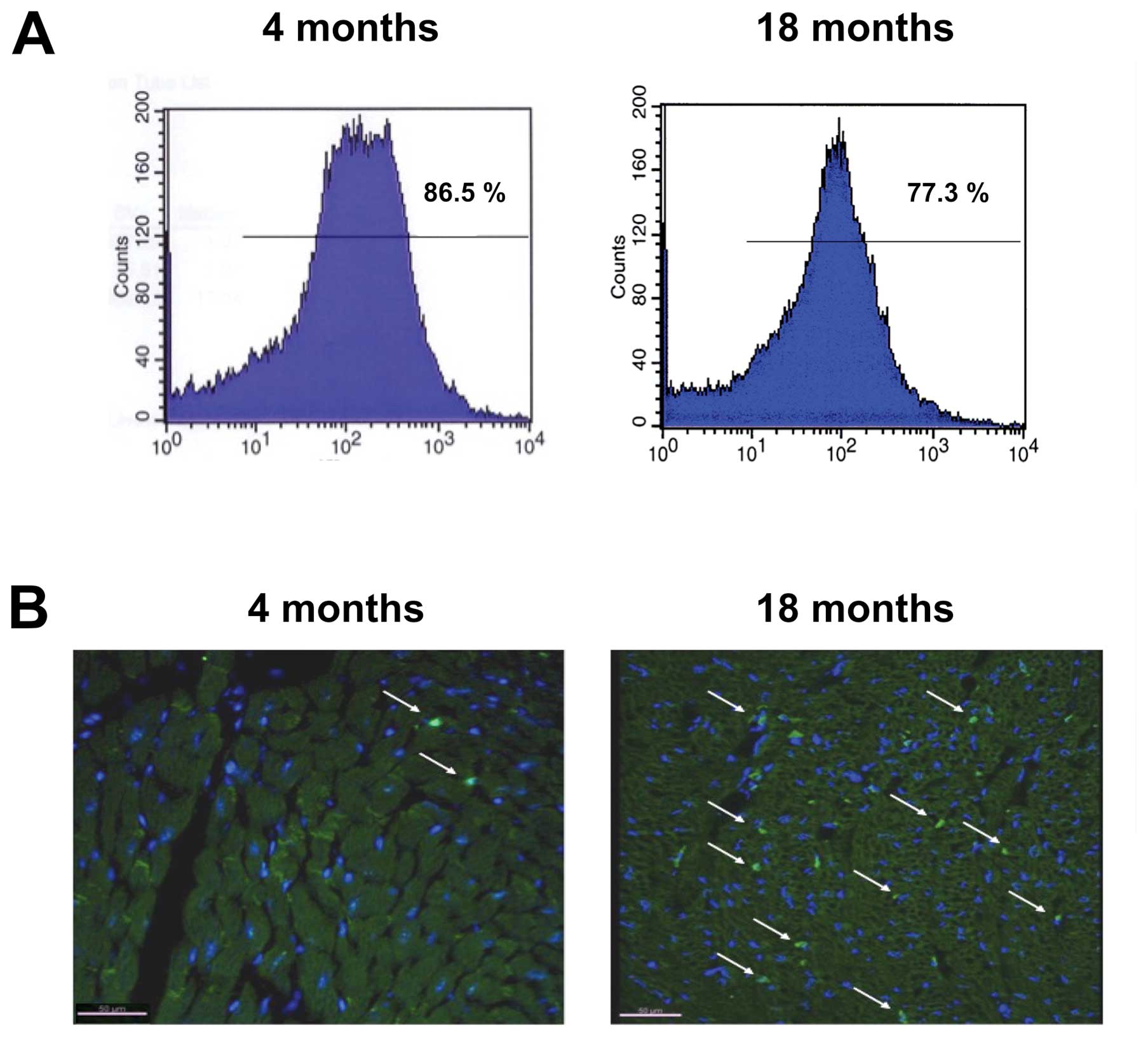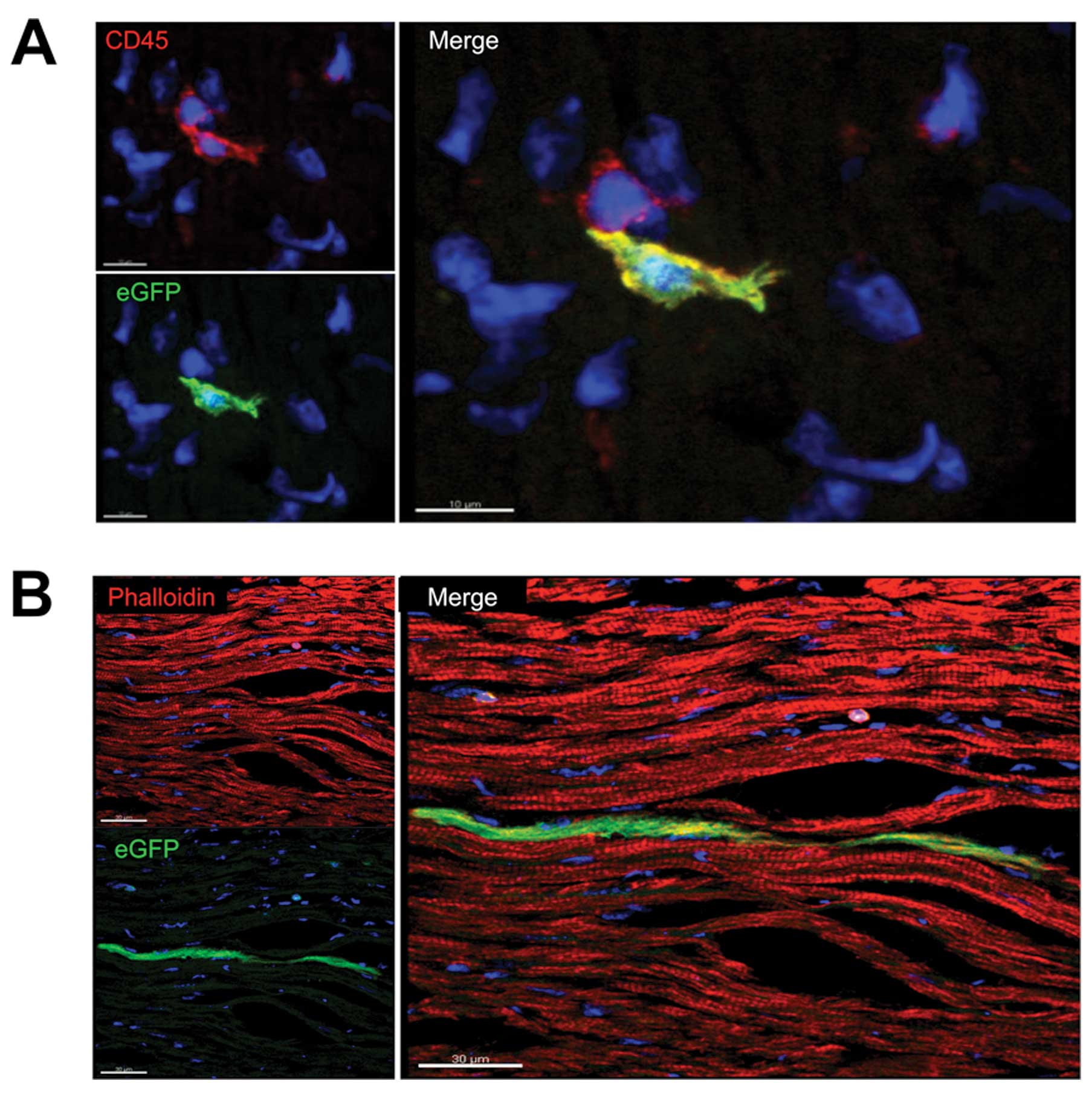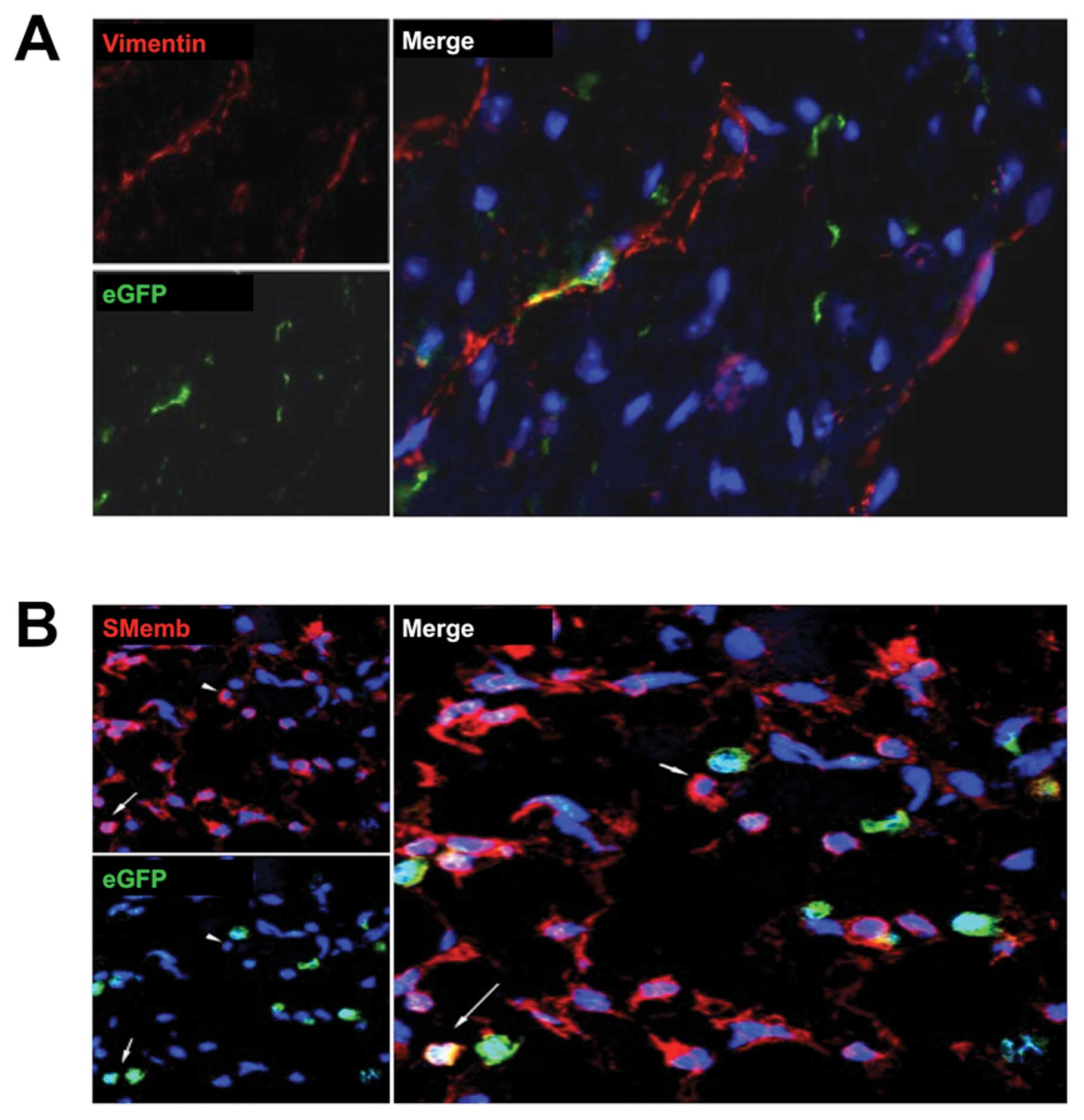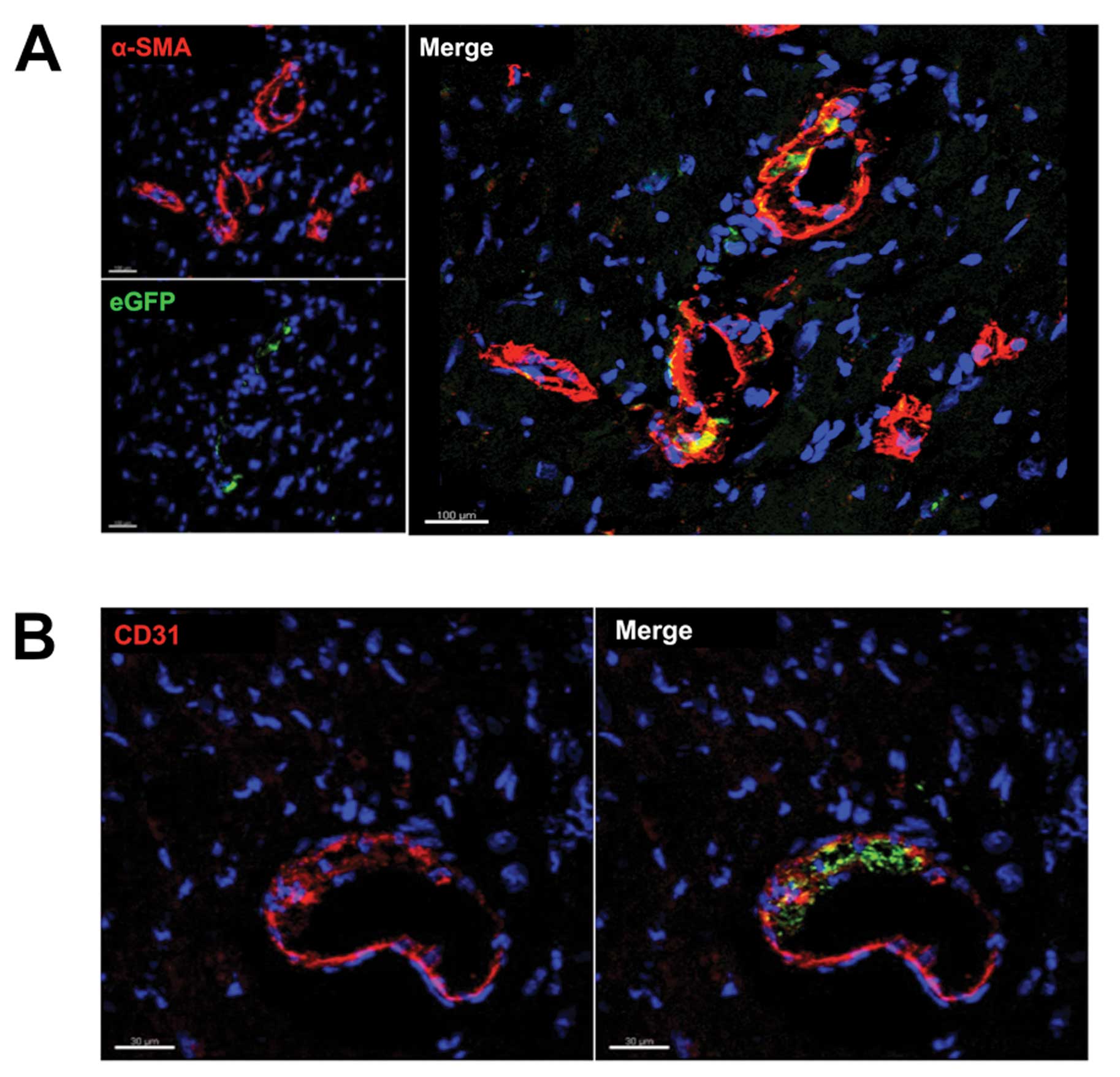Bone marrow-derived cells contribute to cell turnover in aging murine hearts
- Authors:
- Published online on: May 9, 2012 https://doi.org/10.3892/ijmm.2012.995
- Pages: 283-287
Abstract
Introduction
Acute myocardial infarction (AMI) remains a major cause of chronic heart failure (HF) due to a loss of myocardial tissue. Although AMI has been postulated to lead to an irrecoverable loss of cardiomyocytes, bone marrow-derived cells (BMCs) might be able to differentiate into cardiomyocytes after AMI. Several experimental studies have confirmed this cardiomyocytogenic capability of BMCs (1–3), whereas others have excluded the differentiation of BMCs in cardiomyocytes (4–8). Clinical trials have demonstrated beneficial effects of BMC treatment (9–11) after AMI with improved functional parameters (9–11) or a complete absence of effects (12). A recent meta-analysis brought the therapeutic impact of BMCs into question (13). Given these controversial experimental and clinical results, the differential potential of BMCs has been critically challenged and the (patho-)physiological relevance of BMCs in the repair of myocardial damage remains unclear. In order to gain a better understanding of the role of BMCs during pathophysiological processes, improving our knowledge of the physiological role of BMCs in the myocardium is indispensible. Thus, we examined the role of BMCs in the physiological aging processes of the heart. For this purpose, we used a mouse model in which the original bone marrow was replaced by an enhanced green fluorescent protein (eGFP)-marked stem cell pool. These labeled cells offer a possibility of clearly identifying the fate and behavior of potentially differentiated BMC offspring.
Materials and methods
Bone marrow transplantation and transgenic mice
Bone marrow transplantation (BMTx) was performed according to a previously described protocol (6). Briefly, C57BL/6-TgN(ACTbEGFP)1Osb transgenic mice (Jackson Laboratory, Bar Harbor, ME, USA) served as bone marrow donors. In this transgenic line, all cells, with the exception of erythrocytes and hair follicle cells, express eGFP and appear green in the presence of excitation wavelengths (14). A total of 36 mice were transplanted. The success of BMTx was monitored by flow cytometric analysis (FACSCalibur, BD Biosciences, Germany).
In 18 mice, hearts were excised at the age of 4 months to serve as the young control group (group A). To investigate the aging myocardium, 18 mice were euthanized at the age of 18 months (group B).
All investigations conformed to the Guide for the Care and Use of Laboratory Animals published by the US National Institutes of Health (NIH publication no. 85-23, revised 1996) and were approved by the appropriate authorities (Regierungspräsidium Darmstadt, Hessen, Germany).
Perfusion fixation and tissue sampling
The mice were euthanized by cervical dislocation, the thoracic aorta was cannulated, and the hearts were retrograde gravity-perfused at a mean pressure of 100 mmHg with PBS buffer containing 0.1% adenosine (Fluka, Germany) and 0.05% bovine serum albumin (Sigma, Germany) for 3 min, followed by fixative (3% buffered paraformaldehyde solution) for 4 min. Afterwards, the hearts were quickly excised and the tissue cryopreserved in Tissue-Tek OCT Compound (Sakura, Japan) at −80°C until sectioning.
Histological analysis
Serial cryosections of the heart were obtained and 20 representative slices of the whole myocardium were analyzed. Immunostaining was performed on 6-μm cryosections. To assess the incorporation of BM-derived cells into the myocardium, the number of eGFP+ cells in all cryosections was determined. Sections of spleen served as positive controls. An anti-eGFP antibody (Abcam, USA) was used to exclude autofluorescent effects. Staining procedures and picture acquisition were performed as previously described (15). All sections were incubated for 2 h at room temperature. Incubation with the first antibody was followed by treatment with biotinylated secondary antibody when indirectly labeled antibodies were used. The directly labeled antibodies were conjugated to Cy3. The last incubation was carried out with streptavidin-Cy2 (Rockland Immunochemicals, Inc., USA). Nuclei were stained with DRAQ-5 (Alexis, USA). Omission of the primary antibody served as a negative control. Pictures were captured with a Leica TCS SP laser scanning confocal microscope (Leica, Germany) equipped with appropriate filter blocks using a Silicon Graphics Octane workstation (Silicon Graphics, USA) and three-dimensional multichannel image processing software (Bitplane, Germany).
Flow cytometric analysis
The efficacy of BMTx was determined by fluorescence-based flow cytometry (FCM) of eGFP expression in peripheral blood leukocyte subpopulations. Briefly, aliquots of peripheral blood were stained with a panel of APC-conjugated monoclonal antibodies against CD3, CD4, CD8, CD11b, CD19, and F4/80. Following erythrocyte lysis and washing steps, acquisition was performed on a BD FACS Calibur flow cytometer (BD Biosciences, Germany). Data were analyzed using the CellQuest Software (BD Biosciences).
For tissue analysis, hearts were minced and digested in ADS buffer (0.11 M NaCl, 5 mM KCl, 5 mM dextrose, 0.8 mM MgSO4, 12.5 mM NaH2PO4, 20 mM HEPES) containing 1 mg/ml collagenase IV and 0.5 mg/ml hyaluronidase. The resulting cell suspension was filtered through a 70 μm cell strainer (BD Biosciences) and washed twice in PBS/2% fetal calf serum prior to FCM (EPICS Altra, Beckman Coulter).
Results
Bone marrow transplantation
The efficacy of BMTx was assessed by FACS analysis of the peripheral blood at different time points after transplantation. Fluorescence intensity showed that 86.5±5.3% of all nucleated cells in group A and 77.3±4.9% in group B expressed eGFP after BMTx, indicating successful replacement of the original stem-cell population (Fig. 1A). In addition, the proportional leukocyte subpopulations were compared between transplanted and non-transplanted mice using flow cytometry. No significant differences were found between groups, indicating that the white blood cell counts were within the physiological range at the time of surgery (data not shown).
Quantification and phenotype of eGFP+ cells
Four weeks after BMTx, group A mice were euthanized. Immunohistochemical staining of the myocardium revealed only a small number of eGFP+ cells, which were unexceptional leukocytes. In total, <1 eGFP+ cells/mm2 was observed in myocardium samples from group A. In contrast, 9.4±2.8 eGFP+ cells/mm2 were counted in group B samples (Fig. 1B). For additional quantification, hearts were digested and isolated cells analyzed for eGFP by flow cytometry. This quantification documented 0.25±0.03% eGFP+ cells in group A and 4.2±1.2% in group B.
In order to investigate the differentiation of BM-derived cells within the myocardium, cryosections were co-stained with cell type-specific markers. Most of the leukocytes were eGFP+ as demonstrated by positive immunohistochemical staining with the pan-leukocyte marker CD45 (Fig. 2A). In contrast to group A, a considerable number of eGFP+ cells did not positively stain for CD45 in group B, revealing transdifferentiation into a non-inflammatory cell type.
Cardiomyocytes were characterized by anti-titin staining. We examined 10 hearts per group, detecting only five cardiomyocytes that were eGFP+ (group A n=3, group B n=2; Fig. 2B). Immunohistochemicl staining for vimentin showed that some cells co-expressed this fibroblast marker with eGFP, indicating a BM-derived origin in group B (Fig. 3A). To detect myofibroblasts, we used the specific marker SMemb. A considerable number of myofibroblasts were eGFP+, mainly in group B (Fig. 3B). The occasional eGFP+ vascular smooth muscle cells were found primarily in the walls of smaller vessels (Fig. 4A). We also detected bone marrow-derived endothelial cells, which were represented by positive co-staining for eGFP and the endothelial cell marker CD31. These cells were also found primarily in small vessels and capillaries (Fig. 4B). However, the vast majority of CD31+ cells were negative for eGFP.
Discussion
The adult mammalian heart has long been considered a terminally differentiated, postmitotic organ. However, this dogma has been challenged as the role of BMCs in cardiac repair has been extensively investigated, driven by the goal of developing novel therapies aimed at regenerating the damaged myocardium. The bone marrow comprises a wide variety of stem cells, which are able not only to generate blood cells, but to differentiate into other cell types, including liver cells, neurons, skeletal muscle and endothelial cells (16). During physiological cardiac aging, the heart undergoes several structural and morphological changes, including a substantial increase in interstitial and perivascular fibrosis (17), a progressive loss of cardiomyocytes due to necrosis and apoptosis, hypertrophy of the remaining cardiomyocytes and an increase in the number of cardiac fibroblasts (18). These changes can be designated as ‘age-associated cardiomyopathy’ (19).
In this study, we demonstrated that during the lifespan of mice, 4% of cells within the myocardium are recruited from the bone marrow. These BMCs differentiated into tissue-resident leukocytes or transdifferentiated into fibroblasts and myofibroblasts. Differentiation into smooth muscle cells and endothelial cells was rarely observed. In addition, only a negligibly small number of eGFP+ cardiomyocytes was detected, indicating that BMC differentiation into these cell types does not contribute to the regenerative processes of the myocardium during aging. These findings are in agreement with data published by Daniel et al (20), who demonstrated that the differentiation of BMCs into smooth muscle cell or endothelial cell lineages is an extremely rare event. The failure of BMCs to transdifferentiate into cardiomyocytes has been clearly shown in our previous work (6) and by that of several other authors (4,5,8).
In contrast, we found a remarkable number of fibroblasts and myofibroblasts of BMC origin. An increased number of cardiac fibroblasts and myofibroblasts in the aging heart has been described (18,21), though several authors found a blunted capacity of fibroblast proliferation during physiological aging (22,23). Given this discrepancy, the origin of these fibroblasts has remained controversial; the traditional view is that activated myofibroblasts are derived from resident fibroblasts through proliferation and activation. However, tracking the proliferating cell populations localized proliferating fibroblast-like cells in the surrounding blood vessels, indicating that these fibroblasts may be recruited by circulating progenitor cells (24,25). This suggestion is in accordance with data demonstrating BMC differentiation in different cardiovascular pathologies (6,26,27). However, the role of BM-derived progenitor cells in the aging heart was unclear. For the first time, our study demonstrates substantial recruitment of BMCs during physiological cardiac aging and relevant differentiation of BMCs into fibroblasts and myofibroblasts. The increased number of BM-derived fibroblasts and myofibroblasts found in our setting may be due to the aging heart having a reduced capacity for fibroblast and myofibroblast formation (23,28). In this context, the increased homing and transdifferentiation of BMCs can be considered a compensatory mechanism for the progressive loss of different cell types in the aging heart.
This awareness might be therapeutically relevant because the age-related increase in post-AMI mortality is at least partially caused by an impaired response of senescent fibroblasts to fibrogenic mediators, resulting in unfavorable scar tissue formation and subsequently disturbed myocardial performance (29–31). Therefore, therapeutic approaches that increase the homing and differentiation of BMCs may enhance the reparative potential of the aged heart after myocardial damage.
The design of the present study is descriptive and data were obtained from a rather small sample size. The considerably small percentage of eGFP+ cells made quantification of the different cell types and statistical analysis impossible. Further experimental studies are required to confirm the hypothesis that BMCs contribute to cell turnover in the heart during physiological cardiac aging. In addition, the data were acquired in mice. Due to obvious different physiological properties (lifespan, cell turnover), the observations made in our study might not fully translate to human physiology. Nevertheless, our data provide new insights into the physiological impact of BMCs.
In conclusion, our study demonstrates that BMCs trans-differentiate into fibroblasts and myofibroblasts in the aging murine myocardium, suggesting their contribution to the preservation of myocardial structural integrity while they do not account for the regenerative processes of the heart.













